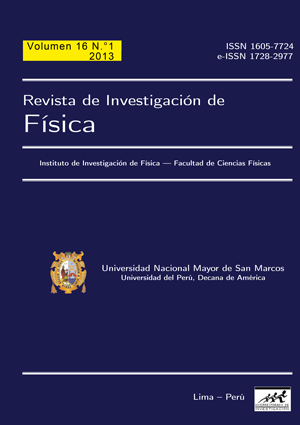Artifical graphene lattice in 2D electron systems in GaAs/AlGaAs
DOI:
https://doi.org/10.15381/rif.v16i01.9178Keywords:
Graphene electronic structure, magnetoresistence, electronic transport on graphene.Abstract
The graphene, since 2004, had show some exceptional mechanical, thermal and electronic properties in se- veral configurations such as optical modulators, transistors, gas detectors, electrocromic devices, electrodes, thermal dissipaters and integrated circuits. There is an inconvenient in the atom by atom manipulation for obtain the specific properties for each function in each proposed device. We account between them, the disorder in the graphene structure and the intercalation of impurities in the hexagonal structure and the imperfections of the substrate that incorporate ripples in the graphene structure. Nevertheless, these do not modify the cones of the valence and conduction bands. The Dirac point remains. Other options has been suggested to induce a gap between the K and K′ symmetry points where lay the Dirac points in which converge the two charge carrier cones, electrons and holes. One of them is to build an artificial hexagonal lattice over a two dimensional electron gas which found near to the interface of the two semiconductor material with different gaps, GaAs/AlGaAs. Therefore, the objective of the present work is to verify if the artificial hexagonal lattice simulate the electronic properties of graphene, i.e., to verify the existence of Dirac points in an artifical hexagonal lattice.Downloads
Published
Issue
Section
License
Copyright (c) 2013 D. I. Arrieta, J. M. Marchena, R. A. Montalvo, J. W. Flores, P. H. Rivera

This work is licensed under a Creative Commons Attribution-NonCommercial-ShareAlike 4.0 International License.
THE AUTHORS RETAIN THEIR RIGHTS:
a. The authors retain their trademark and patent rights, as well as any process or procedure described in the article.
b. The authors retain the right to share, copy, distribute, perform and publicly communicate the article published in the Revista de Investigación de Física (for example, place it in an institutional repository or publish it in a book), with an acknowledgment of its initial publication in the Revista de Investigación de Física.
c. The authors retain the right to make a subsequent publication of their work, to use the article or any part of it (for example: a compilation of their works, notes for conferences, thesis, or for a book), provided that they indicate the source. of publication (authors of the work, journal, volume, number and date).






